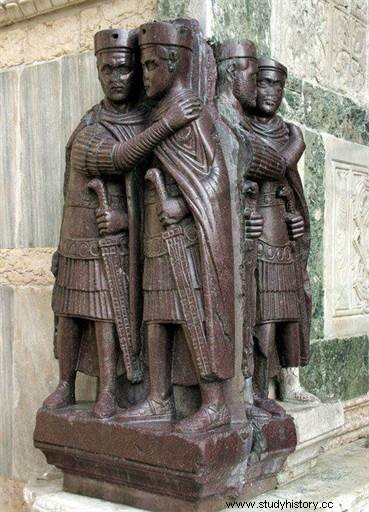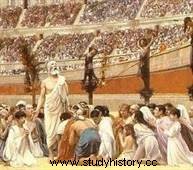 According to historiographical tradition, the Edict of Milan is a letter from Emperors Licinius and Constantine I published in 313, which grants freedom of worship to Christians and put an end to several centuries of persecution. Cardinal Angelo Scola, Archbishop of Milan declared on December 6, 2012 that "in a certain sense, with the Edict of Milan, the two dimensions that we now call 'religious freedom' and 'secularism of the State' appear for the first time in history. If this assertion can provoke debate, this edict of tolerance is indeed an important text in the history of mankind.
According to historiographical tradition, the Edict of Milan is a letter from Emperors Licinius and Constantine I published in 313, which grants freedom of worship to Christians and put an end to several centuries of persecution. Cardinal Angelo Scola, Archbishop of Milan declared on December 6, 2012 that "in a certain sense, with the Edict of Milan, the two dimensions that we now call 'religious freedom' and 'secularism of the State' appear for the first time in history. If this assertion can provoke debate, this edict of tolerance is indeed an important text in the history of mankind.
Before the Edict of Milan:relative peace for Christians
In the 1st and 2nd centuries, Christianity was widely tolerated in the Empire:there were no witch hunts led by the emperors. The only large-scale persecutions listed are that under Nero because of the fire of Rome (in 64) with the martyrdom of Peter and Paul where the imperial power is involved and that of Lyon in 177 which seems to be a local affair whose historians are still struggling to disentangle all the issues with certainty. There are certainly local persecutions of which the letters of Pliny and Tertullian keep track.
However, in both cases, the governors do not systematically hunt down Christians and only judge those who are denounced and who do not deny their faith. In Rome itself, we know that Christians were frowned upon, as illustrated by the words of Tacitus and Pliny regarding them. Thus during the Roman peace, the emperors show clementia towards Christians who retract.
Persecutions:a response to the "crisis" of the third century
 It was during the second half of the 3rd century that the persecutions of Christians took on great proportions. We will not treat in this article the persecution of Maximin the Thracian which seems very limited. It is necessary to wait for Trajan Decius in 249 to have a brief but violent persecution. This emperor had a conservative political program that combines restoration of imperial authority, exaltation of the past and return to traditional values. This last point is very important because according to him the Romans turned away from the gods who took revenge and caused the political, social, cultural, economic and military crises that the Romans faced.
It was during the second half of the 3rd century that the persecutions of Christians took on great proportions. We will not treat in this article the persecution of Maximin the Thracian which seems very limited. It is necessary to wait for Trajan Decius in 249 to have a brief but violent persecution. This emperor had a conservative political program that combines restoration of imperial authority, exaltation of the past and return to traditional values. This last point is very important because according to him the Romans turned away from the gods who took revenge and caused the political, social, cultural, economic and military crises that the Romans faced.
The procedure is simple:everyone summoned had to perform either a sacrifice or burn incense to be awarded a certificate. Those who refused went to jail and went through a whole procedure aimed at bringing them back to the right path. Many accept but consequently become lapsi (a Christian who has denied his faith). Lapsi cause many problems within Christianity (some ecclesiastical authorities are themselves lapsi). Christians are not expressly targeted by this edict and the Roman authorities did not ask Christians to renounce their faith, only that they perform the acts requested.
 The second great persecution is that of Valerian (257-258) which expressly targets Christians. This persecution can be seen as a response to the defeats against the Persians and the plague that still rages. The measures are more restrictive:meetings within the framework of Christian worship are prohibited, the Christian authorities must recognize the gods of the Empire under penalty of exile. These measures seem to have had a relative effect, hence the adoption of more severe news. The results are not yet up to expectations. The capture of Valérien puts an end to the persecutions and his son Gallien publishes an edict of tolerance which aims to calm the situation. It seems that some places have been returned to the Christians. The small peace of the Church takes hold until the great persecution.
The second great persecution is that of Valerian (257-258) which expressly targets Christians. This persecution can be seen as a response to the defeats against the Persians and the plague that still rages. The measures are more restrictive:meetings within the framework of Christian worship are prohibited, the Christian authorities must recognize the gods of the Empire under penalty of exile. These measures seem to have had a relative effect, hence the adoption of more severe news. The results are not yet up to expectations. The capture of Valérien puts an end to the persecutions and his son Gallien publishes an edict of tolerance which aims to calm the situation. It seems that some places have been returned to the Christians. The small peace of the Church takes hold until the great persecution.
Christianity, a religion unsuited to Roman customs
Christian persecutions are not only a response to a specific political crisis but also to a religious problem. Christians cannot participate in the sacrifices which are one of the guarantees of the survival of the Roman order willed by the gods:it is indeed the non-sacrifice for the city more than the non-participation in the imperial worship which is reprimanded. . This non-participation in civic worship also affects the military world all the more after the edict of Caracalla which transforms many Christians into Roman citizens. The martyrdom of the centurion Marcellus illustrates the difficulties that Christians could encounter in the army.
Slah Selmi writes:“The Acts of Saint Marcel took place on July 21, 295. It was on the occasion of the feast of the epiphany of the emperors, it is i.e. the anniversary of the day when Diocletian was proclaimed Jovius, son of Jupiter, and Maximian Herculius, son of Hercules. In the city of Tangier, of which Fortunatus was prefect, there were many rejoicings in the army to celebrate this anniversary. Marcel, one of the centurions of the Trajan legion, approached the trophy of the legion's flags in front of which the sacrifices were being offered.
He threw down his belt saying, "I am a soldier of Jesus Christ, the Eternal King." He also threw down his arms and resumed:"From now on I refuse to serve your emperors, not wanting to adore your gods of wood and stone, deaf and dumb idols"... "It is impossible for a Christian to serve in the militia of the century »... «All the soldiers were banqueting and sacrificing»; “Such was the situation of the military, that they were forced to worship the emperors”...”. I did so in front of the trophy while we were celebrating the Emperor's feast. Therefore he was charged with desertion and blasphemy.” Christianity therefore posed many problems within the framework of the Roman Empire and challenged the pax deorum , the foundation of the Roman religion and therefore the survival of Rome.
The Great Persecutions
 These great persecutions were instituted by Diocletian in 303 and continued until 312, the greatest persecutions ever. either with regard to the number of victims or with regard to the particularly long duration of these persecutions. We will not dwell in detail on the policy of each tetrarch in the matter during this period, especially since there is in the meantime the resignation of Diocletian which marks the beginning of the important struggles between the different protagonists of the empire. Preceded by measures aimed at purifying the army (see the story of Saint Marcel above), the persecutions, although violent, did not have the same intensity depending on the region, given the different temperament of each tetrarch who applied with more or less vehemently the various edicts. However, it is not uninteresting to look at the context in which these abuses emerged.
These great persecutions were instituted by Diocletian in 303 and continued until 312, the greatest persecutions ever. either with regard to the number of victims or with regard to the particularly long duration of these persecutions. We will not dwell in detail on the policy of each tetrarch in the matter during this period, especially since there is in the meantime the resignation of Diocletian which marks the beginning of the important struggles between the different protagonists of the empire. Preceded by measures aimed at purifying the army (see the story of Saint Marcel above), the persecutions, although violent, did not have the same intensity depending on the region, given the different temperament of each tetrarch who applied with more or less vehemently the various edicts. However, it is not uninteresting to look at the context in which these abuses emerged.
As always, the will of the tetrarchs is to ensure that Christians find the right path in religious matters. However, the transformations brought by Diocletian to the Roman Empire made cohabitation with Christians more difficult than before. The ideology that underlies the tetrarchy sanctifies the imperial power of the two Augusti who would be the descendants of Jupiter:the non-devotion of Christians to the traditional gods is therefore intolerable and endangers the State. The oracle of Apollo of Miletus, of which Diocletian was a devotee, did not say otherwise. This theology anticipates the political philosophy of the Christian empire developed by Eusebius of Caesarea. It is also a way for Diocletian to assure his successors of an empire governed by a single faith.
The Sardonic Edict
On April 30, 311, Galerius published in Nicomedia an edict of tolerance called the Edict of Sardica. Although the policy to adopt towards Christians was discussed at the conference of Carnuntum in 308, this text, promulgated without consulting the three other tetrarchs (Constantine, Licinius and Maximin Daïa) proclaims the end of religious persecution and freedom of worship in the whole Empire. Galerius was demonized by Lactantius who saw in him a relentless persecutor who would have even motivated Diocletian, which does not seem to be attested by the other passions of martyrs. This edict is motivated by the observation of the failure of the persecutions:they did not contribute to stopping the progress of Christianity.
According to Arnoldo Marcone, this edict is less intended for subjects than a warning to other tetrarchs:civil wars must be avoided, especially since the Sassanid (Persian) threat is persistent. This edict marks an ideological update of the tetrarchy, an update possible because Galerius is a faithful and authorized interpreter of the Diocletian project. It is then possible to ask Christians to pray for the salvation of the Empire. It is specified in this edict that the governors will receive letters which will stipulate the methods of application of this edict.
The Edict of Milan
Christian historiography has overvalued this edict for obvious ideological reasons. After his victory at the Battle of the Milvian Bridge, Emperor Constantine converted to Christianity, brought freedom to Christians and was the only one who could issue such an edict. But this text is just a decree of application of the edict of Sardonique and is not even an edict. As early as the winter of 312-313, Constantine wrote a letter to the governor of Africa and to the bishop of Carthage for the establishment of the restitution with indemnities of the property of the clergy which followed the edict of Sardonica:the Christianity was already tolerated in some provinces. The Edict of Milan is actually a circular letter from the emperors Constantine I and Licinius which is the result of an interview between the two men in Milan sent to the governor of Bithynia published in Nicomedia on June 13, 313.
This letter was displayed publicly, which enabled Lactantius to copy it into his book On the Death of the Persecutors and to Eusebius of Caesarea for giving us another version in his Ecclesiastical History . Notable additions to the Edict of Sardonica are the return of confiscated books and property to Christians and the removal of municipal obligations for clergy. In the end, this text is the symbol of the definitive end of the persecutions against Christians in the Roman Empire.
Published after the victory of Licinius over Maximin Daia at the Ergenus Campus, near Adrianople, on April 30, 313, this text is the fruit of the alliance between Licinius and Constantine who abolish the Tetrarchy. However, the two men do not have the same vision of this edict:if for Licinius this edict is the last stage, for Constantine, it is a beginning. His involvement in the first councils shows his interest in religious matters. It will still be necessary to wait until the end of the 4th century before the Christian religion becomes the official religion of the empire.
The importance of this edict is therefore much less important than what some historiography has said, even if this text recognizes Christians' right to exercise their worship freely. However, it remains anchored in the collective memory and is the subject of important demonstrations to celebrate it. This memory is not about to stop as illustrated by the mention of this edict in the French program of sixth form of history-geography.
Indicative bibliography
- Marie Françoise Baslez, How Our World Became Christian, Seuil, 2011.
- LANÇON Bertrand and MOREAU Tiphaine, Constantin, a Christian Auguste, Armand Colin, Paris, 2012.
- MARAVAL Pierre, Constantine the Great:Roman Emperor, Christian Emperor (306-337), Tallandier, Paris, 2011.
- VEYNE Paul, When our world became Christian (312-394), Le Livre de Poche, Paris, 2010.
